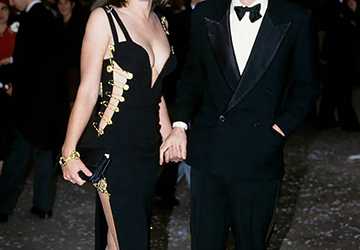Fashion is more than just clothing; it is a language that speaks volumes about cultural, social and personal expression. Over the years, certain moments in fashion have stood out, leaving an indelible mark on the industry and shaping how we think about fashion. Let's deeply dive into the past to discover the iconic fashion moments that left a lasting impression.
1. Coco Chanel's little black dress (1920s)
During the Roaring 1920s, Coco Chanel revolutionized women's fashion by introducing the timeless little black dress. Chanel's creations were fresh air in a world dominated by delicate dresses and restrictive corsets. Simple, elegant and versatile – the little black dress is the epitome of modernity and sophistication.

Chanel's innovative designs free women from the constraints of luxury clothing, providing them with a garment that can transition seamlessly from day to night. The dress became a wardrobe staple, known for its ability to make a statement without screaming. Decades later, the little black dress remains a must-have, proving that simplicity can be the ultimate sophistication.
2. Levi’s 501 jeans (1873)
When it comes to iconic fashion, denim is undoubtedly a timeless classic. The creation of Levi's 501 jeans in 1873 marked the beginning of the denim revolution. Designed initially as rugged work pants for miners during the California Gold Rush, these jeans symbolize rugged individualism and rebellion.
Over the years, the Levi's 501 silhouette has transcended its utilitarian roots and become a cultural phenomenon. From cowboys to rock stars, everyone loves the casual comfort and rebellious spirit of these iconic jeans. Bold studs and rugged denim leave a lasting legacy, making the Levi's 501 a staple in wardrobes worldwide. Dressed or casual, these jeans are always a symbol of authenticity and eternal calm.
3. The Punk Movement and Safety Pins (1970s)
During the rebellious era of the 1970s, the punk movement became a powerful force in music and fashion. The humble safety pin is one of punk fashion's most iconic symbols. Punks embraced a DIY ethos, using safety pins to decorate clothing, pierce body parts, and create an aesthetic that challenged the mainstream.
The safety pin became a symbol of rebellion, anti-establishment sentiment and rejection of traditional norms. Shabby clothes, eye-catching accessories and an uncompromising attitude are the hallmarks of punk fashion. Despite its simplicity, the safety pin became a powerful tool of self-expression, allowing individuals to express dissent and nonconformity through clothing.
4. The sneaker revolution brought about by Air Jordan (1980s)
In the 1980s, basketball legend Michael Jordan collaborated with Nike to create a line of sneakers that redefined sneakers and became a cultural phenomenon. The creation of the Air Jordan sneaker changed the game—on and off the court.
Air Jordans transcend their functional purpose and become symbols of identity, style and urban culture. The iconic "Jumpman" logo and innovative design elements spark the imagination of sneakerheads and fashion enthusiasts alike. The collaboration between sports and fashion paved the way for sneaker culture as we know it today, where sneakers are more than just shoes—they are expressions of identity and style.
5. Princess Diana's Revenge Dress (1994)
In 1994, Princess Diana attended the Vanity Fair party at the Serpentine Gallery, and her outfit made headlines worldwide. The so-called "Revenge Dress" is a figure-hugging off-the-shoulder black dress by Christina Stambolian. Choosing this bold dress was not only a fashion statement; it was a carefully orchestrated reaction to the broadcast of a bombshell interview with Prince Charles.
Princess Diana's revenge dress became an iconic moment in fashion history, demonstrating the power of clothing as a form of self-expression and communication. The garment symbolizes resilience, confidence and the ability to reinvent one's history through style. Decades later, the Revenge Dress is remembered as a fashion moment and a bold statement of independence and strength.
6. Swinging Sixties and Miniskirts (1960s)
The 1960s were a revolutionary era that marked a dramatic shift in social norms and cultural attitudes. One of the most striking signs of this change was the introduction of the miniskirt. British fashion designer Mary Quant is credited with popularizing this bold, free-spirited garment.
Miniskirts challenged traditional notions of modesty and femininity, reflecting the spirit of the Swinging Sixties. Miniskirts are short, playful and full of youthful vitality, symbolizing women's liberation and rejection of conservative fashion. It represented a break from tradition and adopted a lighter, more forward-thinking spirit that had a lasting impact on the fashion world.
7. 1980s power suits
The 1980s saw a shift in women's fashion, marked by the rise of the power suit. As more women enter the corporate world, they seek clothing that reflects their new roles and aspirations. The power suit symbolizes female empowerment, featuring strong shoulders, tailored silhouettes and bold colours.
Designers like Giorgio Armani and Donna Karan played a crucial role in popularizing the power suit and giving women confidence and authority in the workplace. The Power Suit's structured and assertive aesthetic reflects changing gender role dynamics and contributes to a broader cultural shift toward recognizing and respecting women's strength and professionalism.
8. Red Carpet Moment: Liz Hurley's Versace Safety Pin Dress (1994)
In 1994, actress Elizabeth Hurley attended the premiere of Four Weddings and a Funeral with Hugh Grant, causing a stir and media frenzy with her clothing choice. The bold black Versace dress, held together by strategically placed gold safety pins, is instantly eye-catching.

Liz Hurley's iconic red carpet moments thrust her into the spotlight and demonstrated the power of a well-chosen outfit to capture an audience's imagination. With its provocative design, the dress represents a bold departure from traditional red-carpet dressing and highlights the intersection between fashion and celebrity culture.
9. 1970s Bohemian Fashion
The 1970s saw a cultural shift toward a more relaxed, free-spirited lifestyle, reflected in the fashions of the time. Characterized by long flowing skirts, fringe and eclectic patterns, bohemian fashion became a signature style of the 1970s.
The counterculture movement inspired the bohemian look and represented individuality and self-expression. Designers such as Yves Saint Laurent and Missoni were instrumental in popularizing this carefree, unconventional style. The bohemian aesthetic influenced fashion and became synonymous with a broader cultural shift toward embracing diversity and rejecting dominant norms.
10. Streetwear and the rise of Supreme (2000s to present)
The rise of streetwear in the 21st century has significantly impacted the fashion landscape, especially brands like Supreme. What started as a small skate shop in New York City has grown into a global phenomenon, shaping the fashion choices of youth culture worldwide.
Supreme's iconic red and white box logo, collaborations with high-end brands, and limited editions create a sense of exclusivity and hype. The brand's fusion of street culture, art and fashion blurs traditional boundaries, democratizes style and challenges the established norms of the fashion industry. Supreme's success is a testament to the ever-evolving nature of fashion and its ability to be both inclusive and disruptive.
Conclusion:
These iconic moments in fashion have left an indelible mark on history and shaped how we perceive and interact with clothing. From the simplicity of Coco Chanel's little black dress to the rebellious spirit of punk fashion to the cultural impact of Air Jordans, these moments showcase fashion's diversity and transformative power. Every moment tells a unique story and reminds us that clothing is more than just fabric; it is a powerful expression transcending time and trends.






